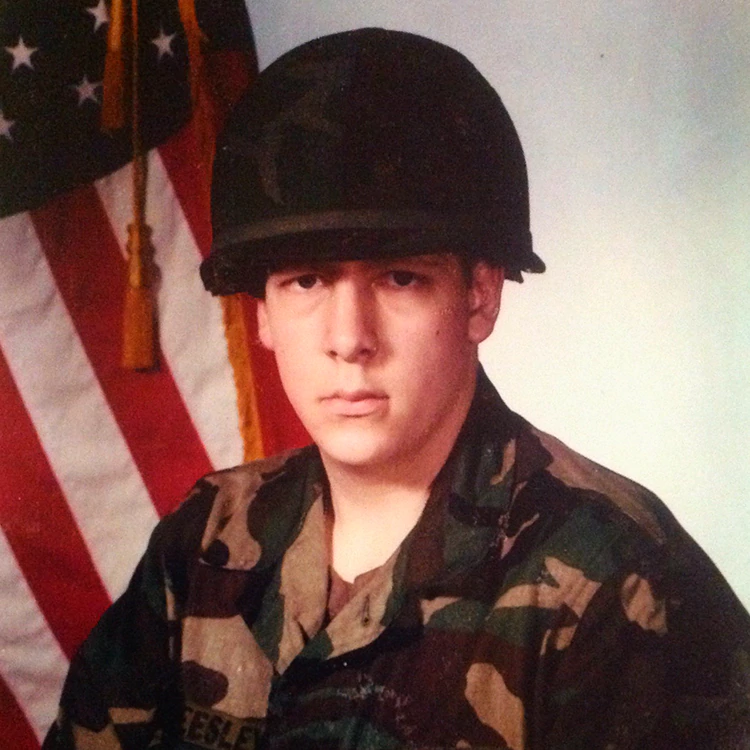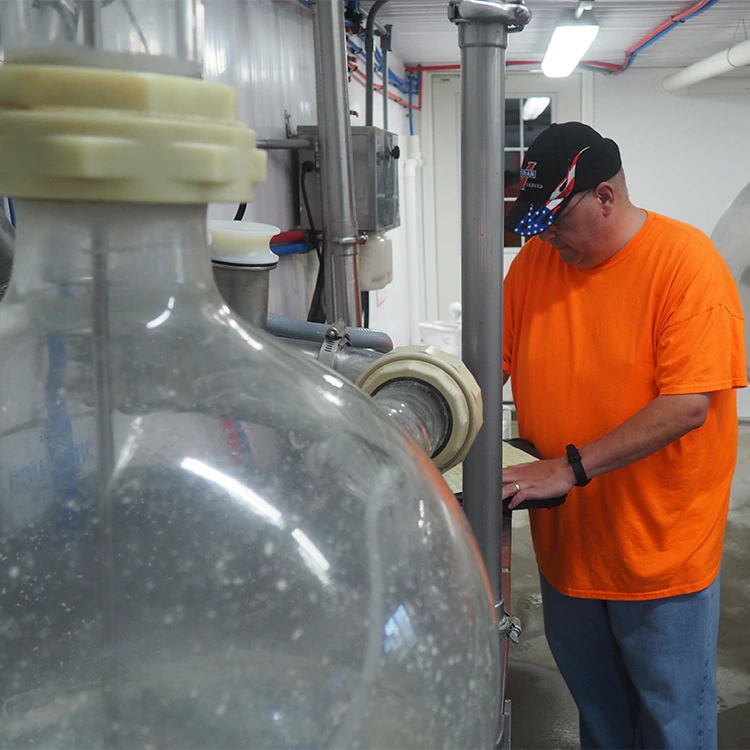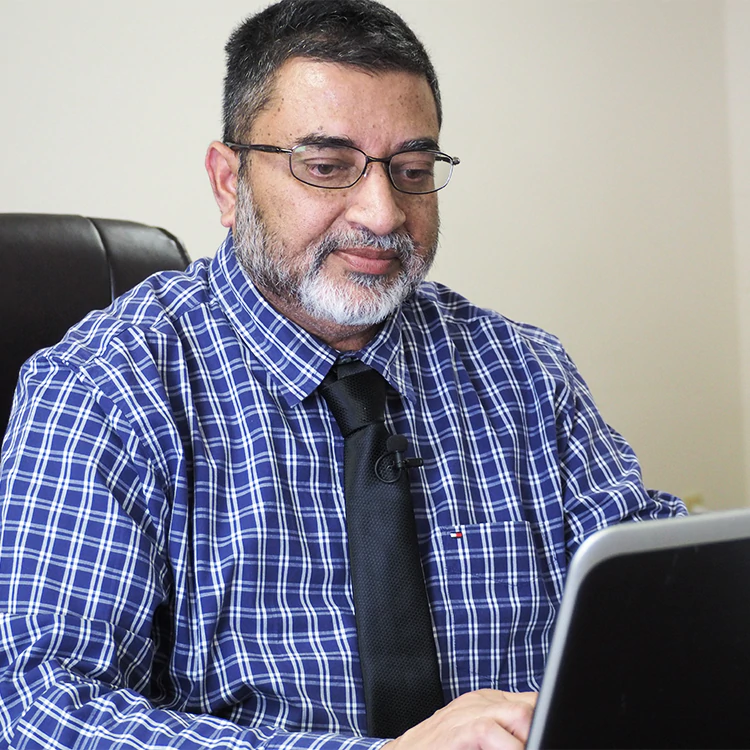Chronic Pain: How Ray Scheesley Got His Life Back
He had lost all hope of controlling his pain until a doctor suggested he try a device made by Medtronic.
Ray Scheesley has survived a lot of things in life.
He’s been bitten by rattlesnakes and shot by enemy soldiers. He was once separated from his military unit and spent 22 days and nights lost and alone in the Amazon jungle. But when chronic pain set in more than a decade ago, he wasn’t sure he could survive it.
“The pain just got to be too much,” Scheesley said. “I asked my wife several times, ‘What’s the point of going on?’ And the doctors kept telling us ‘you’re going to have to live with it.’ We just felt hopeless.”
Scheesley lived in constant, debilitating pain, the result of gunshot wounds he suffered in the military. Enemy bullets found him twice in combat – once as he parachuted into Panama in 1989, and again, two years later, as he tracked drug operations in the Amazon jungle. That time, medics feared the worst.
“I was bleeding dark blood and so my first question to him was ‘Am I going to live to see tomorrow?’ and he said, ‘I don't think so,’” Scheesley recalled.
The bullet tore through his abdomen. His internal injuries kept him hospitalized for 18 months, but the worst problems were yet to come.
Today I have very little pain. It's unbelievable.
Ray Scheesley, who received a Medtronic SynchroMed(TM) II drug infusion system
"I WAS FALLING APART"
Long term effects of his internal injuries began to set in, and in 2005, doctors began prescribing oral opioids to treat the pain.
“The medicine would help for a while,” Scheesley said. “But then the pain would get worse, so they would increase my dosage.”
Side effects from the pain medication — especially nausea and fatigue — intensified with the ever-increasing doses. He felt trapped in a cycle of unbearable pain, more drugs, and more side effects.
“I was falling apart,” Scheesley said. “I did not have a life. I slept a lot. I couldn’t take trips or do basic things with my family without falling asleep. I was having problems at work. We faced bankruptcy. I could barely function during the day.”
Scheesley’s wife Jennifer and their three boys often had to make do without him.
“I can’t think of anything that makes you feel more helpless than watching somebody go through something like this,” Jennifer said. “Because there isn’t anything you can do to help. Nothing.”
But then they met Dr. J.
PAIN PUMP THERAPY
Dr. Muhammad Jalaluddin is a neurosurgeon based in New York who specializes in treating chronic pain. In 2018, he recommended implanting a Medtronic SynchroMedTM II drug infusion system in Scheesley’s abdomen. Rather than oral opioids, the device delivers a tiny amount of pain medication directly into Ray’s spinal fluid – known as the ‘intrathecal space.’
“When we do the intrathecal medication for pain control, it’s targeted to the area where we can block the pain,” said Dr. Jalaluddin.
Because the device releases a small amount of medication near pain receptors in the spine, instead of into the circulatory system, patients typically experience fewer side effects as compared to systemic medications. In Ray’s case, the device delivers a tiny fraction of the amount of pain medication that he had been taking orally. The pump is programmable, and Dr. Jalaluddin periodically refills it with pain medication through a syringe.
The improvement for Scheesley was dramatic.
Since receiving his device, he has started feeling better and has been able to resume his daily living. He's hunting with his sons again. The family took a vacation together for the first time in years, and Ray got a promotion at work. After 13 years of misery, his pain is finally under control.
“Today I have very little pain,” he said. “It’s unbelievable. I feel great. I definitely have my life back."
AMERICA’S PAIN CRISIS1
Scheesley is one of 100 million Americans who experience chronic pain lasting longer than three months.1 That pain problem costs the U.S. between $560 billion and $635 billion a year in direct medical costs and lost productivity.1 Millions more experience pain caused by a specific event, such as surgery or broken bones, that could last six months.[2],[3]
Looking back, the Scheesleys are frustrated they didn’t know about pain pump therapy sooner. “No one told us about this,” said Jennifer. Of all the doctors and specialists we saw over the years, none mentioned this as an option. People need to know what this therapy can do,” she said.
Dr. Jalaluddin believes pump therapy can help others the way it has the Scheesley family.
“Many of the patients I see are feeling hopeless,” he said. “Often they have had chronic pain for 20 or 30 years, but no one told them about this therapy. We need to get the word out. This can work beautifully for the right patients.”
When we do the intrathecal medication for pain control, it’s targeted to the area where we can block the pain.
Dr. Muhammad Jalaluddin, New York neurosurgeon
Federal regulators are beginning to take notice of the potential benefits, too. The U.S. Department of Health and Human Services identified device-delivered therapies such as intrathecal pain pumps, spinal cord stimulation, and vertebral augmentation as procedures that can be considered for managing chronic and acute pain.[6]
The Scheesleys are grateful they’ve finally found a therapy that relieved Ray’s pain.
“I don’t know if even Ray realizes how resilient he is,” Jennifer said. “The pain he’s been through. Most people I know would have given up by now. But not Ray. I’m glad to have him back. It’s about time.”
September is Pain Awareness Month in the United States. Here’s how to learn more.
UC202004932aEN
1 Institute of Medicine. Relieving pain in America: a blueprint for transforming prevention, care, education, and research. Washington DC, United States: The National Academies Press; 2011.
2 Sinatra R. Causes and consequences of inadequate management of acute pain. Pain Med. 2010;11(12):1859-1871.
3 Cleveland Clinic. Acute vs. chronic pain. https://my.clevelandclinic.org/health/articles/12051-acute-vs-chronic-pain. Updated January 26, 2017. Accessed July 2018.
4 Chou R, Deyo RA, Devine B, et al. The effectiveness and risks of long-term opioid treatment of chronic pain: evidence report/technology assessment No. 218. AHRQ publication no. 14-E005-EF. Rockville, MD: Agency for Healthcare Research and Quality; 2014.
5 Dowell D, Haegerich TM, Chou R. CDC Guideline for Prescribing Opioids for Chronic Pain--United States, 2016. JAMA. 2016;315(15):1624-1645.
6 US Department of Health and Human Services. Report on Pain Management Best Practices: Updates, Gaps, Inconsistencies, and Recommendations. 2019; https://www.hhs.gov/sites/default/files/pmtf-final-report-2019-05-23.pdf. Accessed July 2019.
IMPORTANT SAFETY INFORMATION
Review product technical manuals, including information about EMI, and the appropriate drug labeling prior to use for detailed disclosure.
Indications: US: Chronic intrathecal infusion of Infumorph® preservative-free morphine sulfate sterile solution in the treatment of chronic intractable pain, Prialt® chronic intrathecal infusion of preservative-free ziconotide sterile solution for the management of severe chronic pain, and chronic intrathecal infusion of Lioresal® Intrathecal (baclofen injection) for the management of severe spasticity. Outside of US: Chronic infusion of drugs or fluids tested as compatible and listed in the product labeling.
Drug Information: Refer to appropriate drug labeling for indications, contraindications, warnings, precautions, dosage and administration, screening procedures, and under-/overdose symptoms and methods of management. Patients should be informed of the signs and symptoms of drug under- or overdose, appropriate drug warnings and precautions, and signs and symptoms that require medical attention.
Contraindications: System implant is contraindicated in the presence of an infection; implant depth greater than 2.5 cm below skin; insufficient body size; and spinal anomalies. Use of the system with drugs with preservatives and drug formulations with pH ≤3. Use of CAP kit for refills or of refill kit for catheter access and use of PTM to administer opioid to opioid-naïve patients.
Warnings: Non-indicated formulations may contain neurotoxic preservatives, antimicrobials, or antioxidants, or may be incompatible with and damage the system. Failure to comply with all product instructions, including use of drugs or fluids not indicated for use with system, or of questionable sterility or quality, or use of non-Medtronic components or inappropriate kits, can result in improper use, technical errors, increased risks to patient, tissue damage, damage to the system requiring revision or replacement, and/or change in therapy, and may result in additional surgical procedures, a return of underlying symptoms, and/or a clinically significant or fatal drug under- or overdose.
An inflammatory mass that can result in serious neurological impairment, including paralysis, may occur at the tip of the implanted catheter. Clinicians should monitor patients carefully for any new neurological signs or symptoms, change in underlying symptoms, or need for rapid dose escalation. Monitor patients appropriately after refill if a pocket fill is suspected. Failure to recognize signs and symptoms of pocket fill and seek appropriate medical intervention can result in serious injury or death. Overinfusion may lead to underdose or overdose symptoms. Strong sources of electromagnetic interference (EMI) can negatively interact with the pump and cause heating of the implanted pump, system damage, or changes in pump operation or flow rate, that can result in patient injury from tissue heating, additional surgical procedures, a return of underlying symptoms, and/or a clinically significant or fatal drug underdose or overdose. The SynchroMed II system is MR Conditional; consult the labeling for MRI information.
Precautions: Monitor patients after pump or catheter replacement for signs of underdose/overdose. Infuse preservative-free saline at minimum flow rate if therapy is discontinued for an extended period to avoid system damage. EMI may interfere with programmer telemetry during pump programming sessions.
Adverse Events: In addition to procedure-related risks, the following may occur: pocket seroma; hematoma; erosion; infection; pump inversion; post-lumbar puncture risks (spinal headache); CSF leak and rare central nervous system pressure-related problems; radiculitis; arachnoiditis; spinal cord bleeding/damage; meningitis; neurological impairment (including paralysis) due to inflammatory mass; allergic response to implant materials; surgical replacement due to end of service life or component failure; loss of therapy, drug overdose, or inability to program the pump due to component failure; catheter complications resulting in tissue damage or loss of or change in therapy; potential serious adverse effects from catheter fragments in intrathecal space.
For full prescribing information, please call Medtronic at 1-800-328-0810 and/or consult Medtronic’s website at www.medtronic.com
Infumorph® is a registered trademark of West-Ward Pharmaceutical. Prialt® is a registered trademark of TerSera Therapeutics LLC. Lioresal® is a registered trademark of Saol.
USA Rx Only
Rev 1118



